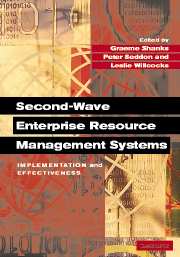Book contents
- Frontmatter
- Contents
- List of Contributors
- Introduction: ERP – The Quiet Revolution?
- Part I Implementation and Effectiveness: Overview
- 1 Learning from Adopters' Experiences with ERP: Problems Encountered and Success Achieved
- 2 Innovating with Packaged Business Software: Towards an Assessment
- 3 A Comprehensive Framework for Assessing and Managing the Benefits of Enterprise Systems: The Business Manager's Perspective
- 4 The Continuing ERP Revolution: Sustainable Lessons, New Modes of Delivery
- Part II From Risks to Critical Success Factors
- Part III From Learning to Knowledge
- Part IV Cultural Aspects of Enterprise Systems
- Part V Future Directions
- Index
- References
4 - The Continuing ERP Revolution: Sustainable Lessons, New Modes of Delivery
from Part I - Implementation and Effectiveness: Overview
Published online by Cambridge University Press: 05 February 2012
- Frontmatter
- Contents
- List of Contributors
- Introduction: ERP – The Quiet Revolution?
- Part I Implementation and Effectiveness: Overview
- 1 Learning from Adopters' Experiences with ERP: Problems Encountered and Success Achieved
- 2 Innovating with Packaged Business Software: Towards an Assessment
- 3 A Comprehensive Framework for Assessing and Managing the Benefits of Enterprise Systems: The Business Manager's Perspective
- 4 The Continuing ERP Revolution: Sustainable Lessons, New Modes of Delivery
- Part II From Risks to Critical Success Factors
- Part III From Learning to Knowledge
- Part IV Cultural Aspects of Enterprise Systems
- Part V Future Directions
- Index
- References
Summary
Introduction
Recognizing the need to present a single face to global customers, to respond rapidly to customer demands, and to seek out economies of scale, business executives have been for some time regularly examining the capabilities offered by information technology (IT). As a result, from the mid 1990s on, many firms have been replacing the legacy systems that form the base of their information processing capabilities with enterprise resource planning systems (ERPs). ERPs replace a firm's disparate transaction processing systems with a single, integrated system that embodies the newly understood tight interdependencies among a firm's functional units. ERPs have offered much promise for revitalizing IT infrastructures and enabling global business process integration (O'Leary, 2000; Sauer and Willcocks, 2001), but as the research in this book demonstrates, implementation of these highly touted systems has regularly proven to be very expensive, and the rewards for implementation often appear to be elusive.
A Mckinsey report looking at the 1995–2000 period concluded that spending on IT in the USA had doubled, as had the labour productivity annual growth rate over the same period. However, despite claims to the contrary, little of that productivity growth could be attributed to IT, and in fact the majority of the US economy saw no or little productivity growth while accounting for 62% of the IT spending in that period.
- Type
- Chapter
- Information
- Second-Wave Enterprise Resource Planning SystemsImplementing for Effectiveness, pp. 102 - 132Publisher: Cambridge University PressPrint publication year: 2003
References
- 13
- Cited by



